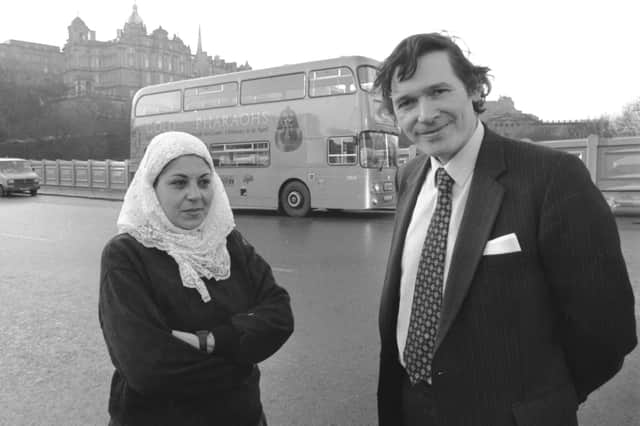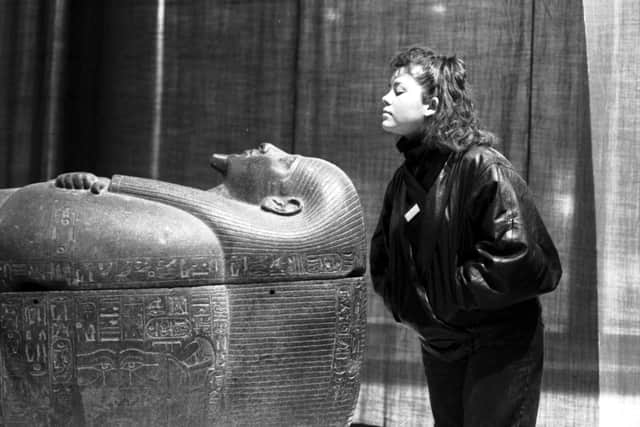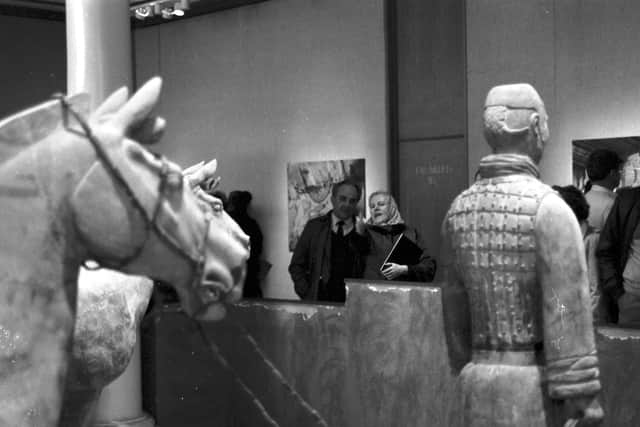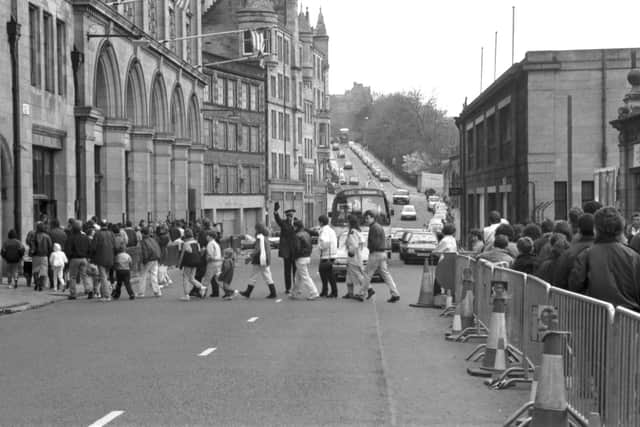City Art Centre at 40: Former curator reflects on early years of Edinburgh institution


As if imbued with the spirit of legendary Egyptologist Howard Carter, the City Art Centre has enabled us all to set eyes on “wonderful things” over the past four decades.
As the Capital institution marks 40 years since the Lord Provost presided over its official opening, we reflect on the art centre’s many successes, including the immense popularity of its blockbuster exhibitions of the ‘80s and ‘90s, and the sheer volume of priceless treasures and Scottish and international art it has brought right to our doorstep.
Advertisement
Hide AdAdvertisement
Hide AdOne man who was there from the very start was Herbert Coutts, Edinburgh City Curator between 1971 and 1999.


A trained archaeologist, Herbert was responsible for the art centre’s inception and played a leading role in attracting huge and spectacular exhibitions to Scotland’s capital in the run up to the Millennium.
In 1972, he visited the Tutankhamun exhibition in London and wondered if it might be possible to bring such collections to Edinburgh.
Speaking to the Evening News, Herbert said: “My vision was of a space that could take temporary exhibitions, drawing from permanent fine art collections, but also collections as important as the Tutankhamun exhibition. That was demonstrated when we were able to secure the Gold of the Pharaohs exhibition for Edinburgh. Without the City Art Centre, that wouldn’t have been possible.”
The art centre was a by-product of Scottish Devolution in the late 1970s. In a bid to accommodate a Scottish Assembly, the Labour Government had purchased the Royal High School, where the City Art Centre was then housed.


While Labour’s devolution plan failed to materialise, Edinburgh District Council used the money obtained from the sale of the building to move the art centre to new premises – a former fruit warehouse on Market Street.
Following its grand opening, the new City Art Centre soon developed a reputation for displaying works of international significance, with themes ranging from Matisse sculpture to Michelangelo drawings and Pisarro in Venezuela to Piranesi drawings and etchings.
But while there was heavy focus on fine art, it was a diet of “blockbuster” exhibitions that helped the fledgling art centre truly take flight and attract hundreds of thousands of people through its doors every year.
Advertisement
Hide AdAdvertisement
Hide AdThe first of these, The Emperor’s Warriors (1985) featured the world-famous terracotta figures from the burial enclosure of the first Emperor of China.


The first cultural exhibition in Scotland to be advertised on television and backed by media mogul Robert Maxwell, it attracted a whopping 221,128 visitors. The Scotsman dubbed the scenes on Market Street “The Great Queue of China”.
“I was told I was crazy,” said Herbert, “that it was after the Edinburgh Festival, when the city becomes a desert and it won’t get the visitors – but they came in large numbers that exceeded everyone’s expectations.”
Encouraged by the tremendous swell of visitors, the City Art Centre embarked on a regular series of similar blockbusters, many echoing the 1980s cultural fascination with tomb-raiding and building on the popularity of Hollywood movies such as the Indiana Jones franchise.
The peak for the blockbusters came in 1988 with the arrival of the Gold of the Pharaohs, a collection of priceless treasures and artefacts from Ancient Tanis in Egypt. It doubled the attendance record set by The Emperor’s Warriors.
Herbert said: “It needed [Egyptian leader] President Mubarak to agree for the Gold of the Pharaohs to come to Edinburgh. The insurance value was about £30 million. It would be a hell of a lot more now.
“The pharaonic gold objects were outstanding in quality and beauty and it made a big impression on everybody who came.
“I was absolutely delighted to see this colour image of the funerary mask of Psusennes on the front of The Scotsman. It made history as the first time a colour photo was used on The Scotsman’s front page.”
Advertisement
Hide AdAdvertisement
Hide AdLater exhibitions, including Dinosaurs Alive! (1990), Sweat of the Sun – Gold of Peru (1990), and Star Trek – The Exhibition (1992), all attracted in excess of 100,000 visitors.
Despite occasionally receiving “stick” from art historians, Herbert remains very proud of the blockbusters’ legacy and the impact they had on young minds.
He said: “Attracting 100,000 is a major target to achieve. Very few cultural exhibitions, even today, achieve more visitors than that.
“The Dinosaurs Alive! exhibition was the first robotic dinosaur exhibition in the UK. There was a great flood of them some years later, but that was the first of them. People just hadn’t seen anything like it. It attracted a thousand school parties – a thousand.
“And for the Star Trek exhibition, we brought Scotty, James Doohan, to Edinburgh and that was fantastic. All the Trekkies turned out for him.
“There was a young woman I met at the Scottish Arts Council years ago. She grew up in the Western Isles, and her dad had decided that seeing the Emperor’s Warriors was a once in a lifetime opportunity and without the need to travel to China. That was the start of her interest in the arts.
“When you put on an exhibition, it’s like throwing pebbles in a pool; you don’t know how far the ripples will travel.”
To celebrate its 40th anniversary, the City Art Centre is mounting a special ‘highlights’ exhibition from the City’s collection of Scottish art.
Advertisement
Hide AdAdvertisement
Hide AdVisitors will be able to see works by major historical figures such as Allan Ramsay, the pioneer photographers Hill and Adamson, and the Scottish Colourists, as well as contemporaries such as John Byrne, Alison Watt and Adrian Wiszniewski.
Two forthcoming exhibitions, City Art Centre at 40: Highlights from the City’s art collection and Bright Shadows: Scottish Art in the 1920s will mark the re-opening of the gallery to the public which is hoped will go ahead next month.
Forty years of ‘blockbuster’ exhibitions
1985: The Emperor’s Warriors
1986: Thunderbirds are Go!
1988: Gold of the Pharaohs
1989: Muppets, Monsters and Magic
1990: Dinosaurs Alive!
1990: The Art of Lego
1990: Sweat of the Sun – Gold of Peru
1992: Star Trek – The Exhibition
1993: Land of the Dragon: Dinosaurs from China
1993: Golden Warriors of the Ukrainian Steppes
1997: Music100
2001: The Quest for Camelot
2002: The Art of Star Wars
2004: Titanic: the World Class Collection
2006: Immortal Pharaoh
2008: Space Age
A message from the Editor:
Thank you for reading this story on our website. While I have your attention, I also have an important request to make of you.
The dramatic events of 2020 are having a major impact on many of our advertisers - and consequently the revenue we receive. We are now more reliant than ever on you taking out a digital subscription to support our journalism.
Subscribe to the Evening News and enjoy unlimited access to Edinburgh news and information online and on our app. Visit https://www.edinburghnews.scotsman.com/subscriptions now to sign up.
By supporting us, we are able to support you in providing trusted, fact-checked content for this website.
Joy Yates
Editorial Director
Comments
Want to join the conversation? Please or to comment on this article.